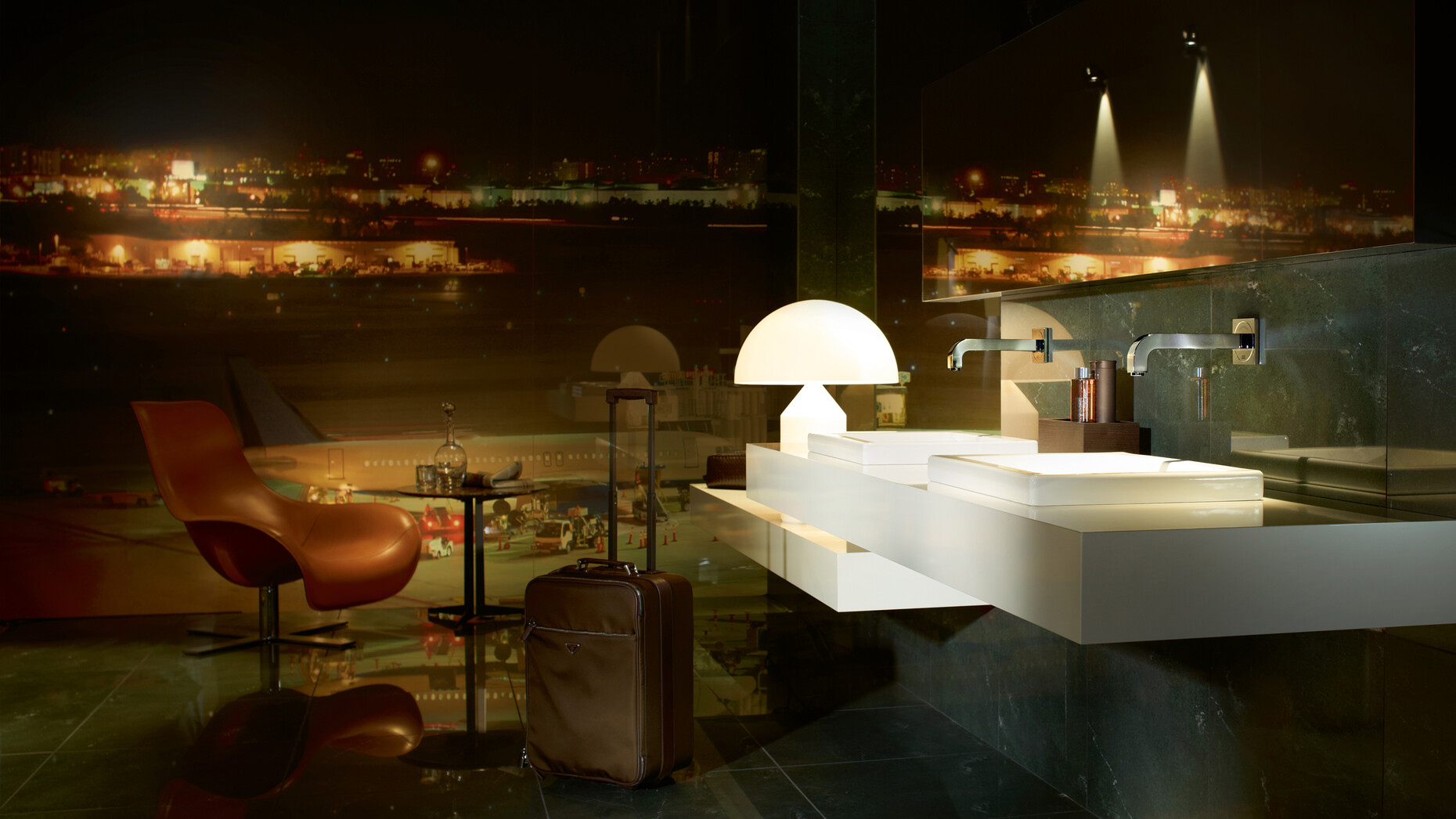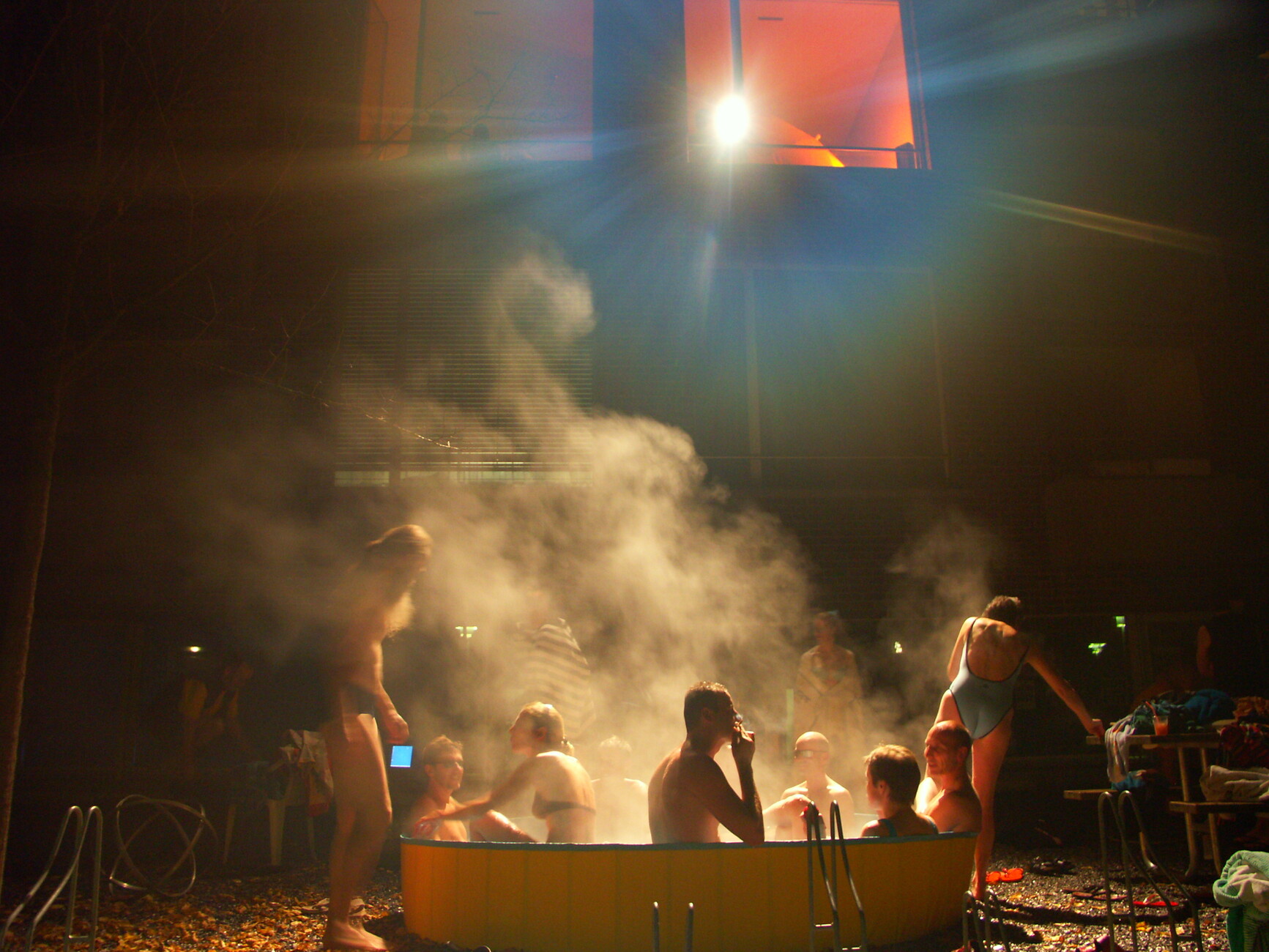Stylepark Axor
A butler in the bathroom
Usually you would expect trade fair presentations to showcase new products and services for an international audience. With the Axor Talks however, AXOR/Hansgrohe SE offered an opportunity for further discussion at the ISH outside its own booth. On the other hand, trade fairs are not debate clubs. As part of the trend forum “Pop up my Bathroom,” a one-hour discussion round was held on three successive days. And they were well attended, as they convincingly combined future and present, practice and research projections.
Under the overall heading “Individualization” three topics were discussed in depth. The first round focused on smart hotel bathrooms, the second day revolved around effects of the megatrend ‘individualization’ on the hotel bathroom. Finally, bathroom sharing concepts were put up for discussion. Against the background of changed lifestyles in the course of democratic change this was arguably the most visionary topic, complete with politically relevant implications. Process consultant and coach Bernhard Heuvelmann moderated the three discussion rounds in a smart, restrained and firm manner, owing to which they retained their common thread. Participants in each round included creative professionals, inquisitive pragmatists, and users and planners of new technologies, resulting in the articulation of different positions.
AXOR TALK 1
Hotel bathrooms go digital
One topic that came under discussion was businesspeople’s expectations of modern hotel bathrooms. Should they be primarily functionally used spaces in the morning and serve relaxation in the evening? Which possibilities does digitization offer? For Ian Biglands, responsible for developing the hotel chain Premier Inn, which sees itself as a “Premium Economy” brand, this still seems a somewhat difficult topic, because it is out of reach. Only those elements that catch on as standard features in the four- and five-star segment have a chance in other hotel classes in economic terms, he says. Yet new features are rapidly becoming more widespread, such as shower-WCs, and will soon reach all price and amenities classes of hotels, he adds.
Designer Bernd Eigenstetter in contrast, who works in the area of user interfaces and user experience at Phoenix Design, considers digitization an opportunity for enhanced functionalities; those who generate more and better data from their customers can offer added value and achieve a great impact with comparatively low costs. He thinks that checking the weather forecast and news or ordering a taxi in the bathroom are conceivable. Uta Kurz, who trained in product design, works as a coach and translates the non-verbal language of design for all those who make design decisions without being prepared to do so. For her digitization in hotels already plays a significant role today in lighting planning and management, for example with the energizing blue light in the morning and calming red light in the evening that are electronically added to LED luminaires. Those days are gone when the cost of materials and fittings in a luxury hotel were negligible. Today, subsequent costs such as cleaning and maintenance are factored in at an early stage, she notes.
How digital do hotel bathrooms need to be in future? What will be possible and where do you see the limits of feasibility? asked the moderator. Eigenstetter emphasized that a lot of people consider the bathroom the last analog refuge, while others wish to exhaust the new technological possibilities. For instance, he noted, it is already technologically possible to virtually change your hotel room, i.e., to transport yourself to other parts of the world using digital projections. Eigenstetter sees both groups as equally strong. He wonders what form digital luxury will take in future given potential enhancements. Premium hotels will probably develop better service offerings, he thinks, whose logistics would be too much for others.
Uta Kurz draws attention to a key aspect: Digital achievements in a hotel have to be easy to use and actually function. It may sound trivial, but involves a core problem as otherwise the oft-cited emotional experience that users make with technology looms large, namely a feeling of personal inadequacy. Kurz distinguished here between technologies that re permanently installed in the hotel, such as sensors, and those that are controlled by a guest’s Smartphone. Hotel manager Biglands wants water usage to be more effectively controlled by digitizing it. To offer shower user a pleasant experience shower systems today get deployed that use thrice as much water. User monitoring and aspects of sustainability got discussed. As were data gathering, data protection, networked sensor technology, the potential and limits of standardization (behind the wall if possible and not on it).
AXOR TALK 2
Impact of customization
The day after, the functions of the participants in the circle were similar, but with different results. Jeanette Huber of Zukunftsinstitut, Bernd Hollin, a Frankfurt architect and Eva Herrmann, MD of Düsseldorf-based boutique hotel “The Fritz” were on the panel. And once again the focus was on hotel baths, but now as regards the challenges of customization.
Huber outlined what social change means in biographical terms, concluding: “Individualization is changing our biographies”, and in relation to architecture and living she urged: “We no longer need perfect mono-functionality, but rather modular variability, including, for example, in the bathroom.” Architect Hollin who, together with Alexander Radoske, runs a studio of 24 architects and designers, pointed to possibilities, “evoking worlds through constructed substance”, and showed examples from his many years of collaboration with Lufthansa, for which he designed its office lounges and first-class areas in the A380. “Where is design no longer individual, and where, in your view, is it exalted?”, the moderator asked the hotel manager. Like her colleagues the previous day, she makes reference to commercial viability. “As soon as it’s too expensive, it’s no longer of interest for the hotel industry. You’re not building one bathroom, but rather multiple ones. For us it’s only 31, but in bigger establishments with up to 400 bathrooms, the budget is the deciding factor.” In order to stand out, she explained, her hotel “brought design to the fore”. The interior design is by Dutch designer Vivian van Schagen, with wood and marble dominating the style. Black, white and gold define the rooms, while the bathrooms boast shiny gold Axor fittings.
Futurologist Huber was very specific: Comfort and high-tech are much in demand, but as she mentioned briefly the previous day, she is insistent that loss of control over the technology is not acceptable. “We need something like empathetic technology that works in the background.” It’s a little bit reminiscent of the Anglo-Saxon concept of the butler which, despite many PR promises to the contrary, has not yet been replaced by a digital successor. Architect Hollin is ever more interested in the “tension between individualization and identity”; after all, he builds rooms for brands which, alongside the differentiation of surfaces, rely on the recognizability of the brand originator. For hotel manager Herrmann the reliable usability of her luxurious furnishings is key. Nevertheless, she stresses: “In gastronomy it’s largely about psychology.” In order to create wellbeing, it’s important to pay attention to lots of small details. “Our aim was to build something that is high quality, but in no way stuffy, that is sophisticated but has a sense of humor.” For her, the new sustainability is the old longevity.
AXOR TALK 3
Forms of community
The third and final round once again opened up a grand design-political-social tableau. The third Axor talk was about nothing less than alternative forms of living and their structural formation, communal use of bathrooms and the “demographic cohesiveness” of the housing stock. The panel comprised architect Bernhard Franken from Frankfurt, Thomas Bade, director of the Institute for Universal Design in Munich and Stadthagen, and Fabian Kinzler, responsible for residential construction and care facilities at Hansgrohe and Axor, and therefore for clients from the residential property industry and for companies operating care homes.
The debate was about the “demographic cohesiveness” of homes, of alternative models of living, such as sharing concepts in which rooms are shared and used communally. Does that work, aside from innovative hotel and office concepts, even in the bathroom, for example? Architect Franken, whose office specializes in “telling stories using spatial means”, talked about projects in which there is a focus on sharing the space. “A bathroom has never been part of that”, he says. “The future is no longer about the product, but rather the spatial scenario”, claims Thomas Bade from the Institute for Universal Design.
The reluctance to address the topic of demographic change has now given way to economic considerations, he said. The challenges lie not in the new construction of homes that are as disability-friendly as possible, but rather in the existing housing stock. Of this, 2.5 million residential units need to be made “demographically cohesive”. The housing industry estimates the cost at around 15,000 euros per unit, with a large proportion of the funds flowing into the bathroom. For Fabian Kinzler, who, as team leader, is very familiar with the project business for Hansgrohe and Axor, the spatial scenarios Bade spoke about nevertheless require the right products, which cater to a huge variety of groups of users.
While architect Franken is interested in experiments that exceed standards, in dissolving the limitations in the way we live in order to create more space for communally used areas and in exploring long-term stay, boarding or sharing concepts, Bade and Kinzler discussed the expectations of the housing industry. Bade expects to see some kind of bathroom sharing as a forced consequence of economic circumstances, in line with the model of care bathrooms in corresponding establishments. On the previous days, design was seen as an individual bonus, but now it was discussed as a prerequisite in order to be able to remain active in one’s own home environment for as long as possible. Kinzler stated that in current residential building plans, there is a stronger focus on standardization “as the end user would want it”. At the same time, he contradicted expectations of shared bathrooms: Anyone building micro-apartments or minimal student units today, he claims, will always equip them with their own compact bathrooms. “Shared bathrooms reduce a property’s rentability.” Even in residential care homes, private bathrooms are increasingly expected.
Franken sees the tendency towards standardization as a “reflex of the fearful”. He cites the hybridization of hotel and residential design. Instead of a standardization of products and spatial requirements, he would like to see flexible processes becoming the norm. Similarly to the development in the office sector, where long-term rentals of extensive spaces are being replaced by new, hotel-like concepts that require more flexible responses in terms of design, the residential market will also change, he believes. Here, landlords will have to become operators, who continually address the users’ needs for change. The world as a hotel? Bade and Kinzler both expressed doubts with regard to the multiplicity of users and the housing industry. The important thing is to define high furnishing standards, the usability of which can be continually adapted to changed expectations. Bade also called for a changed culture of cooperation between different trades.
While a trade fair does not provide much space for an in-depth approach to the issues mentioned, each of the three discussion rounds succeeded in addressing current aspects of bathroom design in an incisive manner. “Axor Talks” are definitely emerging as an exciting industry forum.































